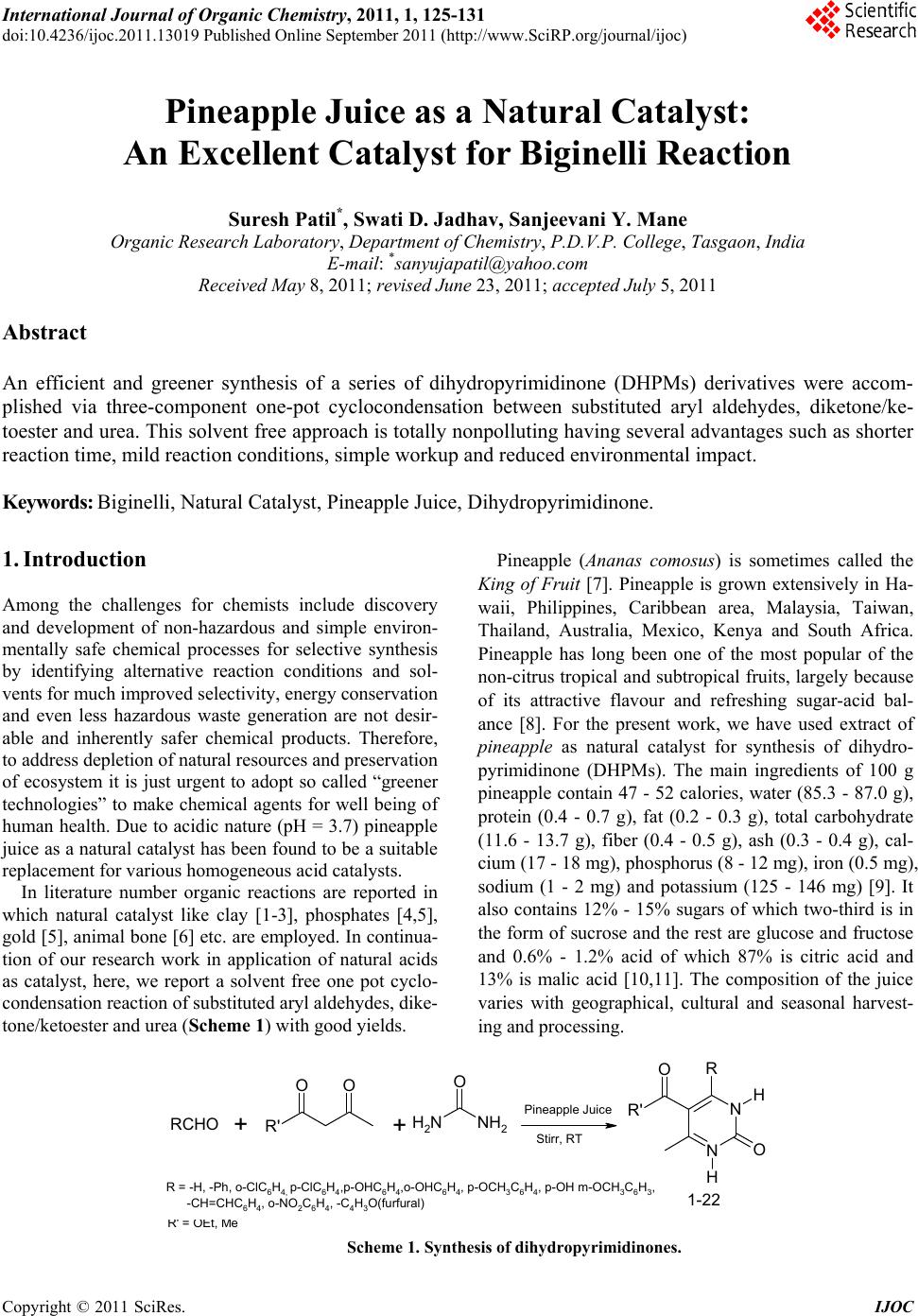 International Journal of Organic Chemistry, 2011, 1, 125-131 doi:10.4236/ijoc.2011.13019 Published Online September 2011 (http://www.SciRP.org/journal/ijoc) Copyright © 2011 SciRes. IJOC Pineapple Juice as a Natural Catalyst: An Excellent Catalyst for Biginelli Reaction Suresh Patil*, Swati D. Jadhav, Sanjeevani Y. Mane Organic Research Laboratory, Department of Chemistry, P.D.V.P. College, Tasgaon, India E-mail: *sanyujapatil@yahoo.com Received May 8, 2011; revised June 23, 2011; accepted July 5, 2011 Abstract An efficient and greener synthesis of a series of dihydropyrimidinone (DHPMs) derivatives were accom- plished via three-component one-pot cyclocondensation between substituted aryl aldehydes, diketone/ke- toester and urea. This solvent free approach is totally nonpolluting having several advantages such as shorter reaction time, mild reaction conditions, simple workup and reduced environmental impact. Keywords: Biginelli, Natural Catalyst, Pineapple Juice, Dihydropyrimidinone. 1. Introduction Among the challenges for chemists include discovery and development of non-hazardous and simple environ- mentally safe chemical processes for selective synthesis by identifying alternative reaction conditions and sol- vents for much improved selectivity, energy conservation and even less hazardous waste generation are not desir- able and inherently safer chemical products. Therefore, to address depletion of natural resources and preservation of ecosystem it is just urgent to adopt so called “greener technologies” to make chemical agents for well being of human health. Due to acidic nature (pH = 3.7) pineapple juice as a natural catalyst has been found to be a suitable replacement for various homogeneous acid catalysts. In literature number organic reactions are reported in which natural catalyst like clay [1-3], phosphates [4,5], gold [5], animal bone [6] etc. are employed. In continua- tion of our research work in application of natural acids as catalyst, here, we report a solvent free one pot cyclo- condensation reactio n of substituted aryl aldehydes, dike- tone/ketoester and urea (Scheme 1) with good yields. Pineapple (Ananas comosus) is sometimes called the King of Fruit [7]. Pineapple is grown extensively in Ha- waii, Philippines, Caribbean area, Malaysia, Taiwan, Thailand, Australia, Mexico, Kenya and South Africa. Pineapple has long been one of the most popular of the non-citrus tropical and subtropical fruits, largely because of its attractive flavour and refreshing sugar-acid bal- ance [8]. For the present work, we have used extract of pineapple as natural catalyst for synthesis of dihydro- pyrimidinone (DHPMs). The main ingredients of 100 g pineapple contain 47 - 52 calories, water (85.3 - 87.0 g), protein (0.4 - 0.7 g), fat (0.2 - 0.3 g), total carbohydrate (11.6 - 13.7 g), fiber (0.4 - 0.5 g), ash (0.3 - 0.4 g), cal- cium (17 - 18 mg), pho sphoru s (8 - 12 mg), iron (0.5 mg), sodium (1 - 2 mg) and potassium (125 - 146 mg) [9]. It also contains 12% - 15% sugars of which two-third is in the form of sucrose and the rest are glucose and fructose and 0.6% - 1.2% acid of which 87% is citric acid and 13% is malic acid [10,11]. The composition of the juice varies with geographical, cultural and seasonal harvest- ing and processing. N N O R H H R' O RCHO R' O O NH2NH2 O ++Pineapple Juice Stirr, RT R' = OEt, Me 1-22 R = -H, -Ph, o-ClC6H4, p-ClC6H4,p-OHC6H4,o-OHC6H4, p-OCH3C6H4, p-OH m-OCH3C6H3, -CH=CHC6H4, o-NO2C6H4, -C4H3O(furfural) Scheme 1. Synthesis of dihydr opyrimidinones. 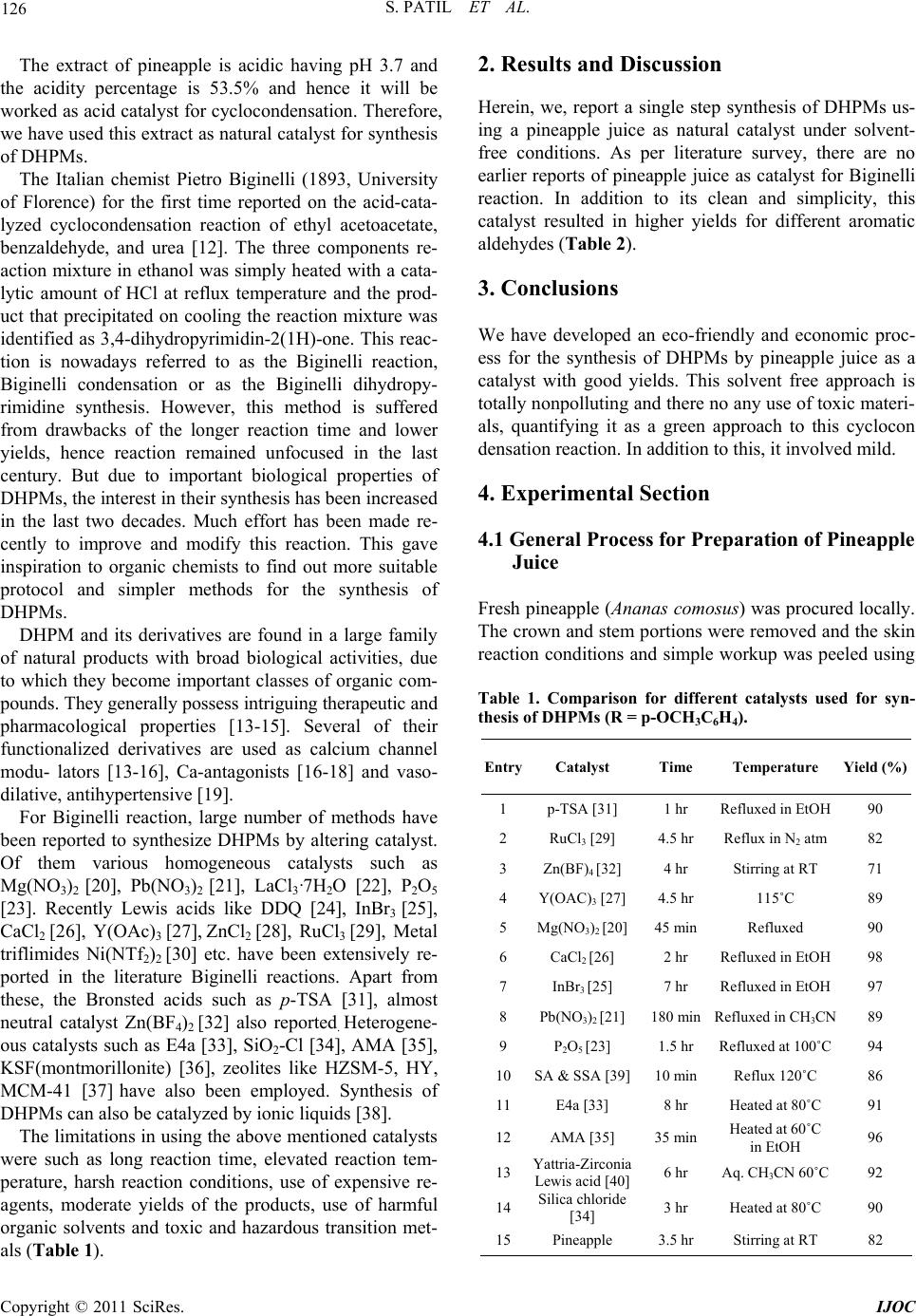 S. PATIL ET AL. 126 als (Table 1). nthesis of DHPMs us- . Conclusions We have developed an eco-friendly and economic proc- . Experimental Section 4.1 General Process for Preparation of Pineapple Fresh pineapple (Ananas comosus) was procured lo cally. Table 1. Comparison for different catalysts used for syn- EntryCatalyst Time Temperature Yield (%) The extract of pineapple is acidic having pH 3.7 and the acidity percentage is 53.5% and hence it will be worked as acid catalyst for cyclocondensation. Therefore, we have used this extract as natural catalyst for synthesis of DHPMs. The Italian chemist Pietro Biginelli (1893, University of Florence) for the first time reported on the acid-cata- lyzed cyclocondensation reaction of ethyl acetoacetate, benzaldehyde, and urea [12]. The three components re- action mixture in ethanol was simply heated with a cata- lytic amount of HCl at reflux temperature and the prod- uct that precipitated on cooling the reaction mixture was identified as 3,4-dihydropyrimidin-2(1H)-one. This reac- tion is nowadays referred to as the Biginelli reaction, Biginelli condensation or as the Biginelli dihydropy- rimidine synthesis. However, this method is suffered from drawbacks of the longer reaction time and lower yields, hence reaction remained unfocused in the last century. But due to important biological properties of DHPMs, the interest in their synthesis has been increased in the last two decades. Much effort has been made re- cently to improve and modify this reaction. This gave inspiration to organic chemists to find out more suitable protocol and simpler methods for the synthesis of DHPMs. DHPM and its derivatives are found in a large family of natural products with broad biological activities, due to which they become important classes of organic com- pounds. They generally possess intriguing therapeutic and pharmacological properties [13-15]. Several of their functionalized derivatives are used as calcium channel modu- lators [13-16], Ca-antagonists [16-18] and vaso- dilative, antihyp ertensive [19]. For Biginelli reaction, large number of methods have been reported to synthesize DHPMs by altering catalyst. Of them various homogeneous catalysts such as Mg(NO3)2 [20], Pb(NO3)2 [21], LaCl3·7H2O [22], P2O5 [23]. Recently Lewis acids like DDQ [24], InBr3 [25], CaCl2 [26], Y(OAc)3 [27], ZnCl2 [28], RuCl3 [29], Metal triflimides Ni(NTf2)2 [30] etc. have been extensively re- ported in the literature Biginelli reactions. Apart from these, the Bronsted acids such as p-TSA [31], almost neutral catalyst Zn(BF4)2 [32] also reported. Heterogene- ous catalysts such as E4a [33], SiO2-Cl [34], AMA [35], KSF(montmorillonite) [36], zeolites like HZSM-5, HY, MCM-41 [37] have also been employed. Synthesis of DHPMs can also be catalyzed by ionic liquids [38]. The limitation s in using the above mentioned catalysts were such as long reaction time, elevated reaction tem- perature, harsh reaction conditions, use of expensive re- agents, moderate yields of the products, use of harmful organic solvents and toxic and hazardous transition met- 2. Results and Discussion Herein, we, report a single step sy ing a pineapple juice as natural catalyst under solvent- free conditions. As per literature survey, there are no earlier reports of pineapple juice as catalyst for Biginelli reaction. In addition to its clean and simplicity, this catalyst resulted in higher yields for different aromatic aldehydes (Table 2). 3 ess for the synthesis of DHPMs by pineapple juice as a catalyst with good yields. This solvent free approach is totally nonpollu ting and th ere no any use of tox ic materi- als, quantifying it as a green approach to this cyclocon densation reaction. In addition to this, it involved mild. 4 Juice The crown and stem portions were removed and the skin reaction conditions and simple workup was peeled using thesis of DHPMs (R = p-OCH3C6H4). 1 p-TSA [31] 1 hr Refluxed in EtOH90 2 RuCl3 [29] 4.5 hr Reflux in N2 atm82 3 Zn(BF)4 [32] 4 hr Stirring at RT 71 4 Y(OAC)3 [27]4.5 hr 115˚C 89 5 Mg(NO3)2 [20] 45 min Refluxed Ref P] 1 SA & SSA [39] 3 Ya Aq. ˚C Pineapple 90 6 CaCl2 [26] 2 hr luxed in EtOH98 7 InBr3 [25] 7 hr Refluxed in EtOH97 8 b(NO3)2 [218 0 min Refluxed in CH3CN89 9 P2O5 [23] 1.5 hr Refluxed at 100˚C94 1010 min Reflux 120˚C 86 11E4a [33 ] 8 hr Heated at 80˚C 91 12AMA [35] 5 min Heated at 60˚C in EtOH CH3CN 60 96 13 attria-Zirconi Lewis acid [40] Silica chloride 6 hr 92 14 [34] 3 hr Heated at 80˚C 90 153.5 hr Stirring at RT 82 Copyright © 2011 SciRes. IJOC 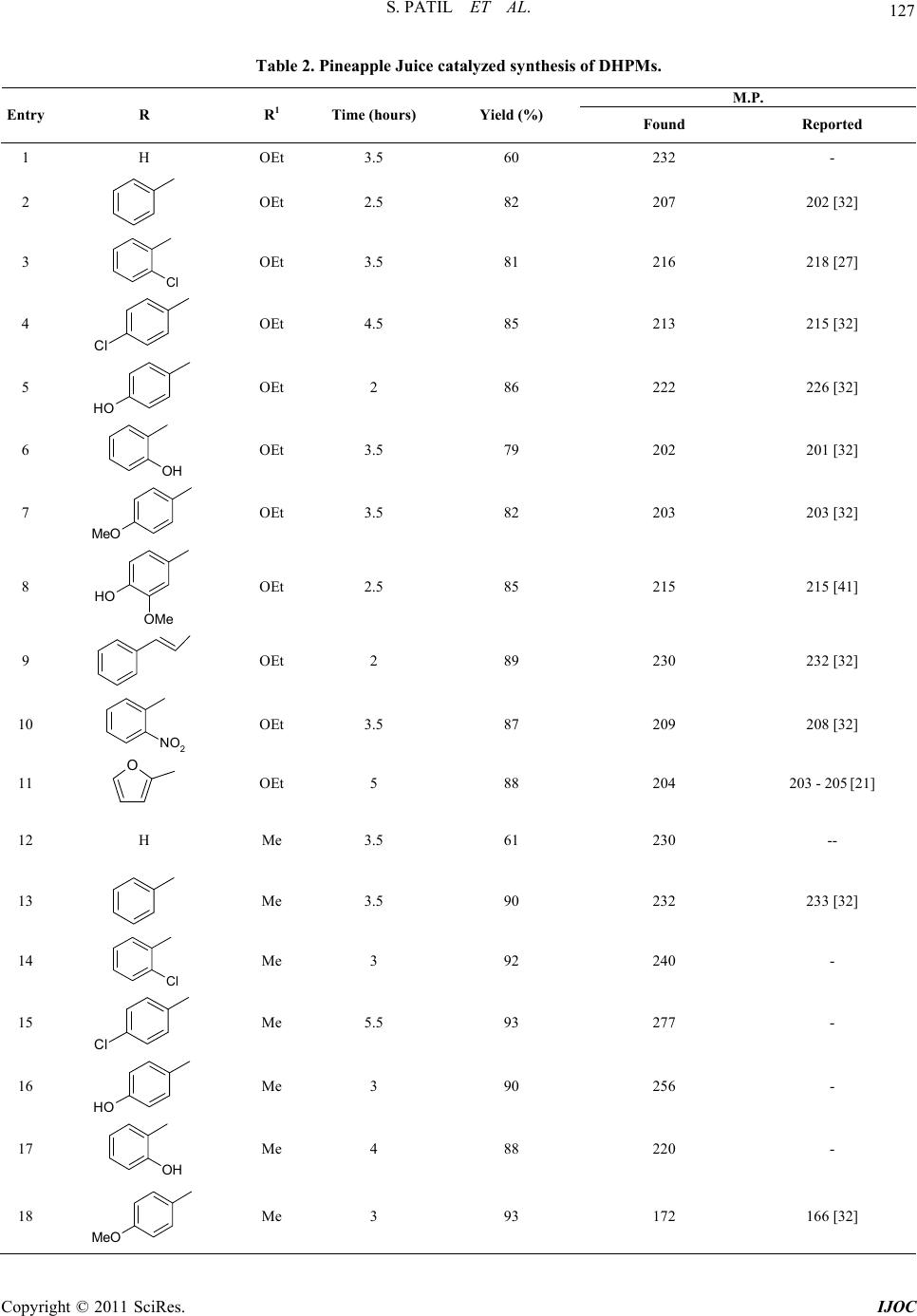 S. PATIL ET AL. 127 apple catalyzed synthesis of DHPM s. M.P. Table 2. Pinee Juic Entry R R Time (hours) Yield (%) Found Reported 1 1 H OEt 3.5 60 232 - 2 OEt 2.5 82 207 202 [32] 3 Cl OEt 3.5 81 216 218 [27] 4 Cl OEt 4.5 85 213 215 [32] 5 OH OEt 2 86 222 226 [32] 6 OH OEt 3.5 79 202 201 [32] 7 MeO OEt 3.5 82 203 203 [32] 8 OH OMe OEt 2.5 85 215 215 [41] 9 OEt 2 89 230 232 [32] 10 NO2 OEt 3.5 87 209 208 [32] 11 O OEt 5 88 204 203 - 205 [21] 12 H Me 3.5 61 230 -- 13 Me 3.5 90 232 233 [32] 14 Cl Me 3 92 240 - 15 Cl Me 5.5 93 277 - 16 OH Me 3 90 256 - 17 OH Me 4 88 220 - 18 MeO Me 3 93 172 166 [32] Copyright © 2011 SciRes. IJOC  S. PATIL ET AL. 128 19 OH OMe Me 2 92 232 - 20 Me 5 89 243 - 21 NO2 Me 2.5 91 230 234 - 236 [21] 22 O Me 4.5 90 197 - kn. Then the fruit was sliced the fslices prfruit juicer r one to two minutes tet the misolid mass which was th en filtered through co tton to enyl)-3,4-dihydropyrimidin-2(1H)-one oxy d as a reptities of to fine yellow crystals of 5-ethoxycarbony6-methyl- 4-(4-ethoxyphenyl)-3,4-dihydropyrimidin-2(1H)-one. The formation of the compound was confirmed by IR, 4. yl)-3,4-dih ydro )-one (Com poun d 7 Table 2): (CHCl3, cm): max 3230, 1720, 1690 cm–1. 2CH3), 5.r-H), 7. ife essed in a d anruit o gfo se get liqui d pineapple j ui c e. 4.2 General Procedure for Synthesis of 5-Ethoxycarbonyl-6-methyl-4-(4-methoxyph The synthesis of 5-ethoxycarbonyl-6-methyl-4-(4-meth- phenyl)-3,4-dihydropyrimidin-2(1H)-one is describe resentative example : The equ imolar quan p-metho-xy- benzaldehyde (1.36 g, 10 mmol), ethyl ace- toacetate, (1.30 g, 10 mmol) and urea (0.6 g, 10 mmol) in 1 ml pineapple juice were stirred for 3.5 hours at room temperature with monitoring by TLC. Then the reaction mixture was filtered, washed with little water. The yel- low solid obtained was then recrystallized with ethanol get ml- NMR and its melting point. This procedure is followed for the synthesis of all the DHPMs listed in Table 2. 3 Spectral Data for Representative Compounds 5-ethoxycarbonyl-6-methyl-4-(4-methoxyphen pyrimidin-2(1H –1 IR 1H NMR (CDCl3): 1.14 (s, 3H, -OCH2CH3), 2.32 (s, 3H, -CH3), 3.78 (s, 3H, -OCH3), 4.05 (s, 2H, -OCH 34 (s, 1H,-NH), 5.90 (s, 1H,-NH), 6.84 (s, 2H, A 21 (s, 2H, Ar-H), 8.42 (s , 1 H, -C H) (Figure 1). Figure 1. NMR Spectrum (1). Copyright © 2011 SciRes. IJOC 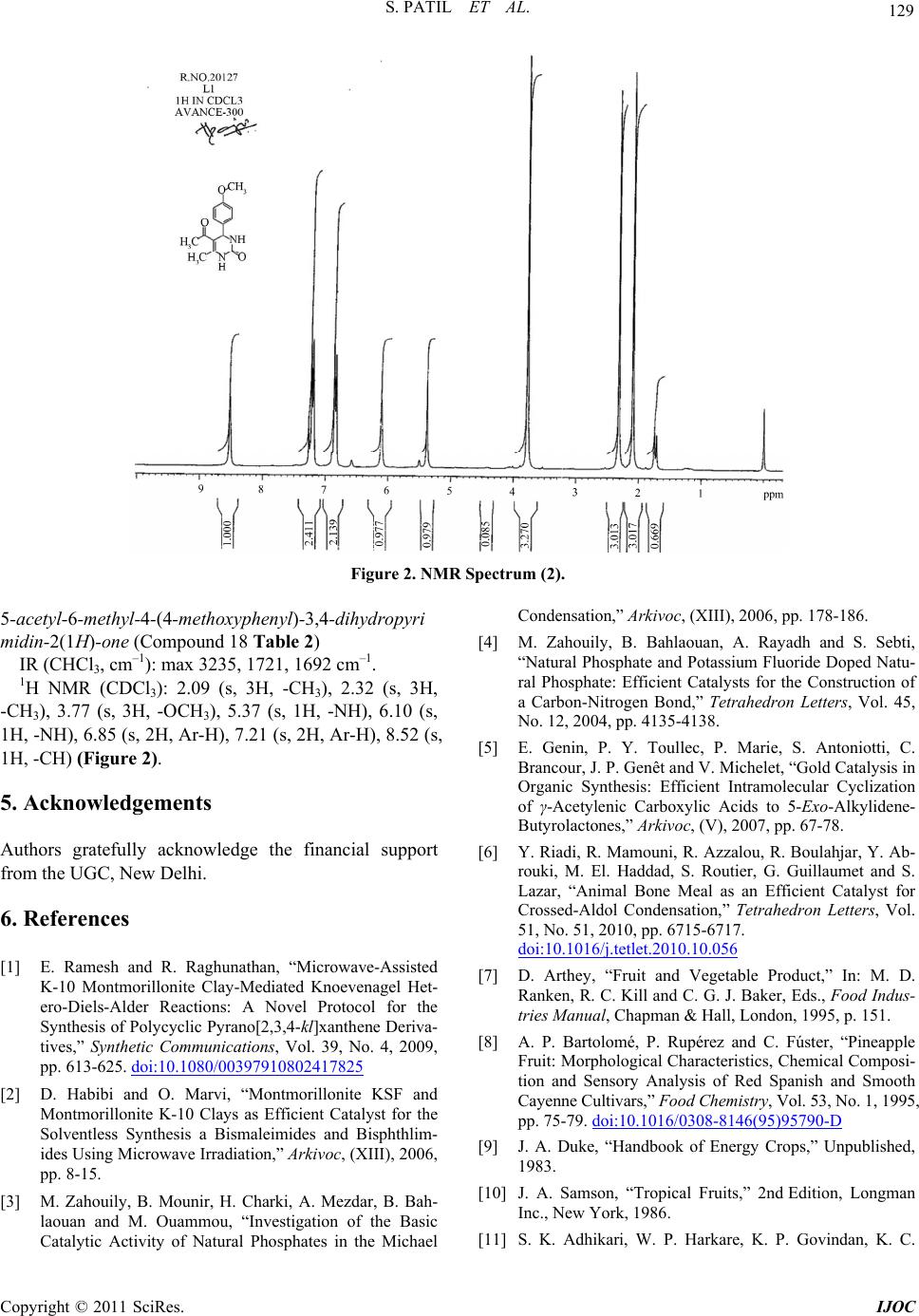 129 S. PATIL ET AL. Figure 2. NMR Spectrum (2). -acetyl-6-methyl-4-(4-methoxyphenyl)-3,4-dihydropyri midin-2(1H)-one (Compound 18 Table 2) IR (CHCl3, cm–1): max 3235, 1721, 1692 cm–1. 1H NMR (CDCl3): 2.09 (s, 3H, -CH3), 2.32 (s, 3H, -CH3), 3.77 (s, 3H, -OCH3), 5.37 (s, 1H, -NH), 6.10 (s, 1H, -NH), 6.85 (s, 2H, Ar-H), 7.21 (s, 2H, Ar-H), 8.52 (s, 1H, -CH) (Figure 2). 5. Acknowledgements Authors gratefully acknowledge the financial support from the UGC, New Delhi. 6. References [1] E. Ramesh and R. Raghunathan, “Microwave-Assisted K-10 Montmorillonite Clay-Mediated Knoevenagel Het- ero-Diels-Alder Reactions: A Novel Protocol for the Synthesis of Polycyclic Pyrano[2,3,4-kl]xanthene Deriva- tives,” Synthetic Communications, Vol. 39, No. 4, 2009, pp. 613-625. doi:10.1080/00397910802417825 5 [2] D. Habibi and O. Marvi, “Montmorillonite KSF and Montmorillonite K-10 Clays as Efficient Catalyst for the Solventless Synthesis a Bismaleimides and ides Using Microwave Irradiation,” Arkivoc, (XIII), 2006, ezdar, B. Bah- asic ,” Arkivoc, (XIII), 2006, pp. 178-186. [4] M. Zahouily, B. Bahlaouan, A. Rayadh and S. Sebti, “Natural Phosphate and Potassium Fluoride Doped Natu- ral Phosphate: Efficient Catalysts for the Construction of a Carbon-Nitrogen Bond,” Tetrahedron Letters, Vol. 45, No. 12, 2004, pp. 4135-4138. [5] E. Genin, P. Y. Toullec, P. Marie, S. Antoniotti, C. Brancour, J. P. Genêt and V. Michelet, “Gold Catalysis in Organic Synthesis: Efficient Intramolecular Cyclization of γ-Acetylenic Carboxylic Acids to 5-Exo-Alkylidene- Butyrolactones,” Arkivoc, (V), 2007, pp. 67-78. [6] Y. Riadi, R. Mamouni, R. Azzalou, R. Boulahjar, Y. Ab- rouki, M. El. Haddad, S. Routier, G. Guillaumet and S. Lazar, “Animal Bone Meal as an Efficient Catalyst for Crossed-Aldol Condensation,” Tetrahedron Letters, Vol. 51, No. 51, 2010, pp. 6715-6717. doi:10.1016/j.tetlet.2010.10.056 Bisphthlim- pp. 8-15. [3] M. Zahouily, B. Mounir, H. Charki, A. M laouan and M. Ouammou, “Investigation of the B Catalytic Activity of Natural Phosphates in the Michael Condensation [7] D. Arthey, “Fruit and Vegetable Product,” In: M. D. Ranken, R. C. Kill and C. G. J. Baker, Eds., Food Indus- tries Manual, Chapman & Hall, London, 1995, p. 151. [8] A. P. Bartolomé, P. Rupérez and C. Fúster, “Pineapple Fruit: Morphological Characteristics, Chemical Composi- tion and Sensory Analysis of Red Spanish and Smooth Cayenne Cultivars,” Food Chemistry, Vol. 53, No. 1, 1995, . doi:10.1016/0308-8146(95)95790-Dpp. 75-79 ke, “Handbook of Energy Crops,” Unpublished, arkare, K. P. Govindan, K. C. [9] J. A. Du 1983. [10] J. A. Samson, “Tropical Fruits,” 2nd Edition, Longman Inc., New York, 1986. 1] S. K. Adhikari, W. P. H[1 Copyright © 2011 SciRes. IJOC 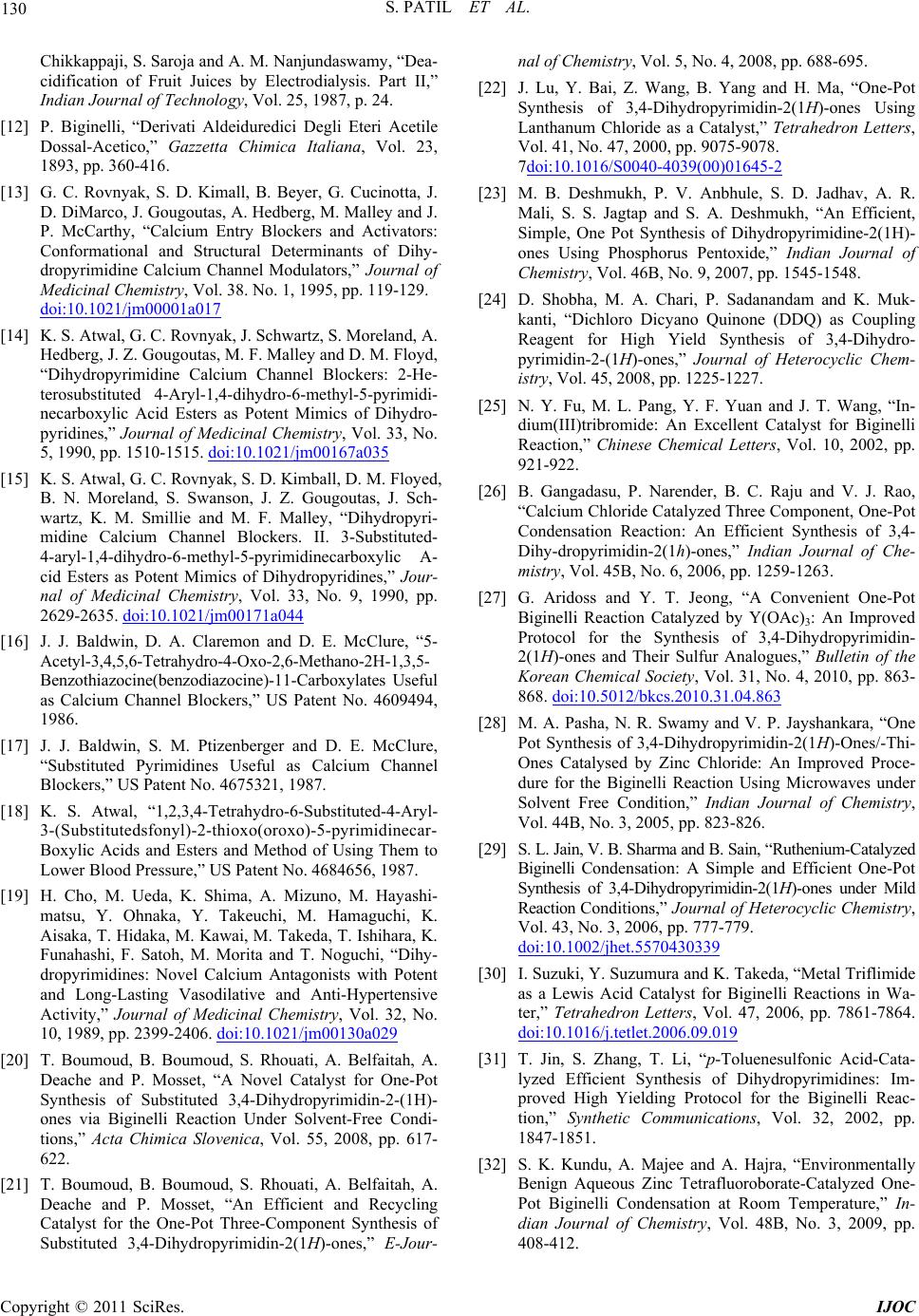 S. PATIL ET AL. 130 A. M. Nanjundaswamy, “Dea- es by Electrodialysis. Part II a Chimica Italiana, Vol. 23, 416. , S. D. Kimall, B. Beyer, G. Cucinotta, J. Chikkappaji, S. Saroja and cidification of Fruit Juic,” Indian Journal of Technology, Vol. 25, 1987, p. 24. [12] P. Biginelli, “Derivati Aldeiduredici Degli Eteri Acetile Dossal-Acetico,” Gazzett 1893, pp. 360- 13] G. C. Rovnyak[D. DiMarco, J. Gougoutas, A. Hedberg, M. Malley and J. P. McCarthy, “Calcium Entry Blockers and Activators: Conformational and Structural Determinants of Dihy- dropyrimidine Calcium Channel Modulators,” Journal of Medicinal Chemistry, Vol. 38. No. 1, 1995, pp. 119-129. doi:10.1021/jm00001a017 [14] K. S. Atwal, G. C. Rovnyak, J. Schwartz, S. Moreland, A. Journal of Medicinal Chemistry, Vol. 33, No. Hedberg, J. Z. Gougoutas, M. F. Malley and D. M. Floyd, “Dihydropyrimidine Calcium Channel Blockers: 2-He- terosubstituted 4-Aryl-1,4-dihydro-6-methyl-5-pyrimidi- necarboxylic Acid Esters as Potent Mimics of Dihydro- pyridines,” 5, 1990, pp. 1510-1515. doi:10.1021/jm00167a035 [15] K. S. Atwal, G. C. Rovnya k, S. D. Kimball, D. M. Floy ed, B. N. Moreland, S. Swanson, J. Z. Gougoutas, J. Sch- wartz, K. M. Smillie and M. F. Malley, “Dihydropyri- midine Calcium Channel Blockers. II. 3-Substituted- 4-aryl-1,4-dihydro-6-methyl-5-pyrimidinecarboxylic A- cid Esters as Potent Mimics of Dihydropyridines,” Jour- nal of Medicinal Chemistry, Vol. 33, No. 9, 1990, pp. 2629-2635. doi:10.1021/jm00171a044 [16] J. J. Baldwin, D. A. Claremon and D. E. McClure, “5- Acetyl-3,4,5,6-Tetrahydro-4-Oxo-2,6-Methano-2H-1,3,5- Benzothiazocine(benzodiazocine)-11-Carboxylates Useful as Calcium Channel Blockers,” US Patent No. 4609494, 1986. [17] J. J. Baldwin, S. M. Ptizenberger and D. E. McClure, “Substituted Pyrimidines Useful as Calcium Channel Blockers,” US Patent No. 4675321, 1987. [18] K. S. Atwal, “1,2,3,4-Tetrahydro-6-Substituted-4-Aryl- 3-(Substitutedsfonyl)-2-thioxo(oroxo)-5-pyrimidinecar- Boxylic Acids and Esters and Method of Using Them to 029 Lower Blood Pressure,” US Patent No. 4684656, 1987. [19] H. Cho, M. Ueda, K. Shima, A. Mizuno, M. Hayashi- matsu, Y. Ohnaka, Y. Takeuchi, M. Hamaguchi, K. Aisaka, T. Hidaka, M. Kawai, M. Ta keda, T. Ishihara, K. Funahashi, F. Satoh, M. Morita and T. Noguchi, “Dihy- dropyrimidines: Novel Calcium Antagonists with Potent and Long-Lasting Vasodilative and Anti-Hypertensive Activity,” Journal of Medicinal Chemistry, Vol. 32, No. 10, 1989, pp. 2399-2406. doi:10.1021/jm00130a and P. Mosset, “A Novel Catalyst for One-P ction Under Solvent-Free Condi- cling l. 5, No. 4, 2008, pp. 688-695. [20] T. Boumoud, B. Boumoud, S. Rhouati, A. Belfaitah, A. Deacheot Synthesis of Substituted 3,4-Dihydropyrimidin-2-(1H)- ones via Biginelli Rea tions,” Acta Chimica Slovenica, Vol. 55, 2008, pp. 617- 622. [21] T. Boumoud, B. Boumoud, S. Rhouati, A. Belfaitah, A. Deache and P. Mosset, “An Efficient and Recy Catalyst for the One-Pot Three-Component Synthesis of Substituted 3,4-Dihydropyrimidin-2(1H)-ones,” E-Jour- nal of Chemistry, Vo [22] J. Lu, Y. Bai, Z. Wang, B. Yang and H. Ma, “One-Pot Synthesis of 3,4-Dihydropyrimidin-2(1H)-ones Using Lanthanum Chloride as a Catalyst,” Tetrahedron Letters, Vol. 41, No. 47, 2000, pp. 9075-9078. 7doi:10.1016/S0040-4039(00)01645-2 [23] M. B. Deshmukh, P. V. Anbhule, S. D. Jadhav, A. R. Mali, S. S. Jagtap and S. A. Deshmukh, “An Efficient, mponent, One-Pot ction Catalyzed by Y(OAc)3: An Improved 2010, pp. 863- Simple, One Pot Synthesis of Dihydropyrimidine-2(1H)- ones Using Phosphorus Pentoxide,” Indian Journal of Chemistry, Vol. 46B, No. 9, 2007, pp. 1545-1548. [24] D. Shobha, M. A. Chari, P. Sadanandam and K. Muk- kanti, “Dichloro Dicyano Quinone (DDQ) as Coupling Reagent for High Yield Synthesis of 3,4-Dihydro- pyrimidin-2-(1H)-ones,” Journal of Heterocyclic Chem- istry, Vol. 45, 2008, pp. 1225-1227. [25] N. Y. Fu, M. L. Pang, Y. F. Yuan and J. T. Wang, “In- dium(III)tribromide: An Excellent Catalyst for Biginelli Reaction,” Chinese Chemical Letters, Vol. 10, 2002, pp. 921-922. [26] B. Gangadasu, P. Narender, B. C. Raju and V. J. Rao, “Calcium Chloride Catalyzed Three Co Condensation Reaction: An Efficient Synthesis of 3,4- Dihy-dropyrimidin-2(1h)-ones,” Indian Journal of Che- mistry, Vol. 45B, No. 6, 2006, pp. 1259-1263. [27] G. Aridoss and Y. T. Jeong, “A Convenient One-Pot Biginelli Rea Protocol for the Synthesis of 3,4-Dihydropyrimidin- 2(1H)-ones and Their Sulfur Analogues,” Bulletin of the Korean Chemical Society, Vol. 31, No. 4, 868. doi:10.5012/bkcs.2010.31.04.863 [28] M. A. Pasha, N. R. Swamy and V. P. Jayshankara, “One Pot Synthesis of 3,4-Dihydropyrimidin-2(1H)-Ones/-Thi- Ones Catalysed by Zinc Chloride: An Improved Proce- dure for the Biginelli Reaction Using Microwaves under Solvent Free Condition,” Indian Journal of Chemistry, Vol. 44B, No. 3, 2005, pp. 823-826. [29] S. L. Jain, V. B. Sharma and B. Sain, “Ruthenium-Catalyzed Biginelli Condensation: A Simple and Efficient One-Pot Synthesis of 3,4-Dihydropyrimidin-2(1H)-ones under Mild Reaction Conditions,” Journal of Heterocyclic Chemistry, Vol. 43, No. 3, 2006, pp. 777-779. doi:10.1002/jhet.5570430339 [30] I. Suzuki, Y. Suzumura and K. Takeda, “Metal Triflimide as a Lewis Acid Catalyst for Biginelli Reactions in Wa- ter,” Tetrahedron Letters, Vol. 47, 2006, pp. 7861-7864. doi:10.1016/j.tetlet.2006.09.019 [31] T. Jin, S. Zhang, T. Li, “p-Toluenesulfonic Acid-Cata- ntally lyzed Efficient Synthesis of Dihydropyrimidines: Im- proved High Yielding Protocol for the Biginelli Reac- tion,” Synthetic Communications, Vol. 32, 2002, pp. 1847-1851. [32] S. K. Kundu, A. Majee and A. Hajra, “Environme Benign Aqueous Zinc Tetrafluoroborate-Catalyzed One- Pot Biginelli Condensation at Room Temperature,” In- dian Journal of Chemistry, Vol. 48B, No. 3, 2009, pp. 408-412. Copyright © 2011 SciRes. IJOC 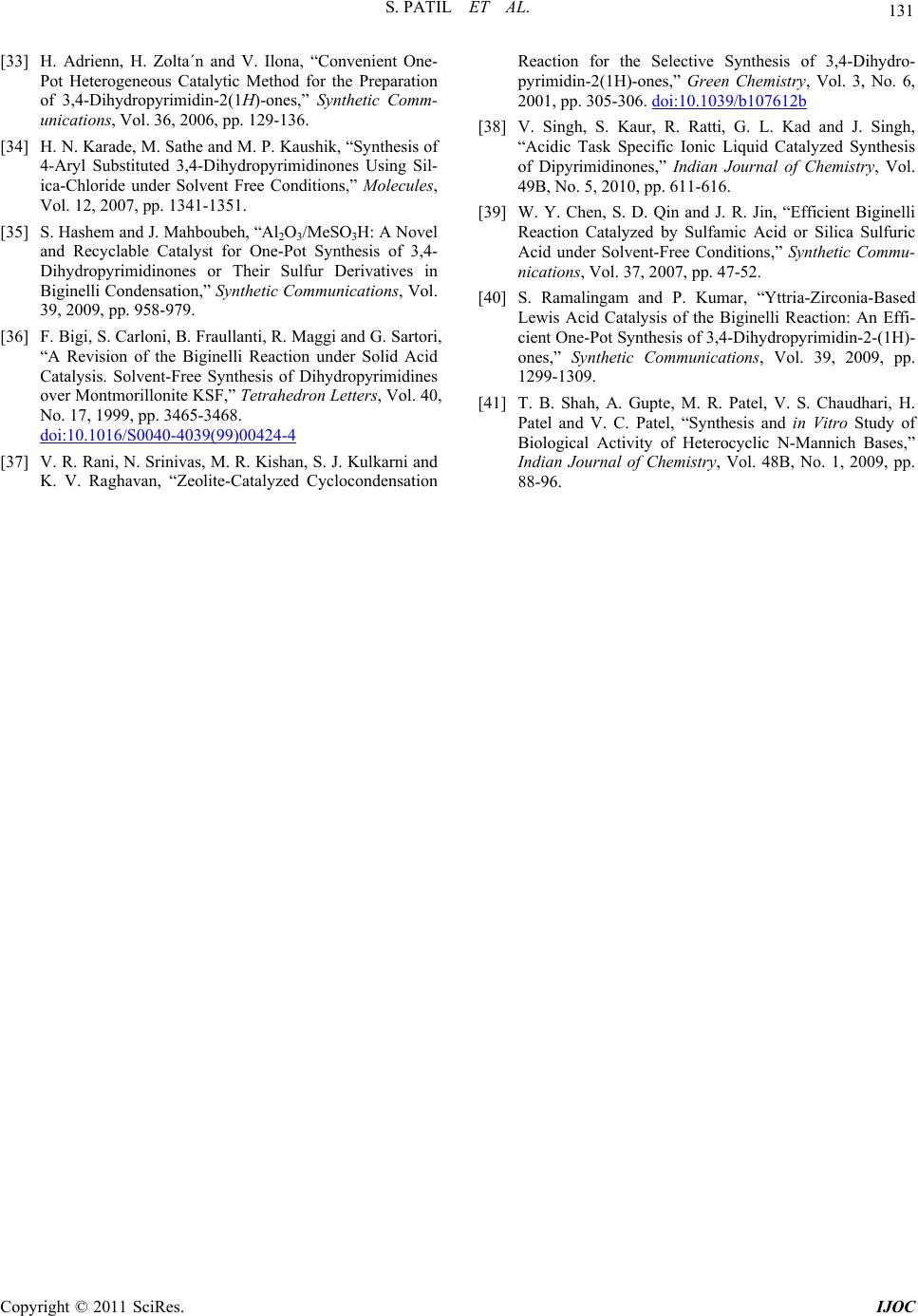 S. PATIL ET AL. Copyright © 2011 SciRes. IJOC 131 Convenient fur Derivatives in on of the Biginelli Reaction under Solid Acid [33] H. Adrienn, H. Zolta´n and V. Ilona, “ One- Pot Heterogeneous Catalytic Method for the Preparation of 3,4-Dihydropyrimidin-2(1H)-ones,” Synthetic Comm- unications, Vol. 36, 2006, pp. 129-136. [34] H. N. Karade, M. Sathe and M. P. Kaushik, “Synthesis of 4-Aryl Substituted 3,4-Dihydropyrimidinones Using Sil- ica-Chloride under Solvent Free Conditions,” Molecules, Vol. 12, 2007, pp. 1341-1351. [35] S. Hashem and J. Mahboubeh, “Al2O3/MeSO3H: A Novel and Recyclable Catalyst for One-Pot Synthesis of 3,4- Dihydropyrimidinones or Their Sul Biginelli Condensation,” Synthetic Communications, Vol. 39, 2009, pp. 958-979. [36] F. Bigi, S. Carloni, B. Fraullanti, R. Maggi and G. Sartori, “A Revisi Catalysis. Solvent-Free Synthesis of Dihydropyrimidines over Montmorillonite KSF,” Tetrahedron Letters, Vol. 40, No. 17, 1999, pp. 3465-3468. doi:10.1016/S0040-4039(99)00424-4 [37] V. R. Rani, N. Srinivas, M. R. Kishan, S. J. Kulkarni and K. V. Raghavan, “Zeolite-Catalyzed Cyclocondensation Reaction for the Selective Synthesis of 3,4-Dihydro- pyrimidin-2(1H)-ones,” Green Chemistry, Vol. 3, No. 6, 2001, pp. 305-306. doi:10.1039/b107612b [38] V. Singh, S. Kaur, R. Ratti, G. L. Kad and J. Singh, “Acidic Task Specific Ionic Liquid Catalyzed Synthesis r Silica Sulfuric ginelli Reaction: An Effi- “Synthesis and in Vitro Study of of Dipyrimidinones,” Indian Journal of Chemistry, Vol. 49B, No. 5, 2010, pp. 611-616. [39] W. Y. Chen, S. D. Qin and J. R. Jin, “Efficient Biginelli Reaction Catalyzed by Sulfamic Acid o Acid under Solvent-Free Conditions,” Synthetic Commu- nications, Vol. 37, 2007, pp. 47-52. [40] S. Ramalingam and P. Kumar, “Yttria-Zirconia-Based Lewis Acid Catalysis of the Bi cient One-Pot Synthesis of 3,4-Dihydropyrimidin-2-(1H)- ones,” Synthetic Communications, Vol. 39, 2009, pp. 1299-1309. [41] T. B. Shah, A. Gupte, M. R. Patel, V. S. Chaudhari, H. Patel and V. C. Patel, Biological Activity of Heterocyclic N-Mannich Bases,” Indian Journal of Chemistry, Vol. 48B, No. 1, 2009, pp. 88-96.
|